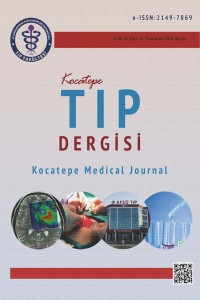Abstract
Amniyon sıvı embolisi (ASE) gebelikte, doğum esnasında veya doğumdan sonra gelişebilen, oldukça nadir görülen ancak yaşamı tehdit eden ciddi bir klinik durumdur. Mortalite oranlarının bazı yayınlarda %90’lara kadar ulaştığı belirtilmektedir. Kesin tanı postmortem incelemede amniyotik sıvı komponentlerinin annenin pulmoner dolaşımında görülmesi ile konur. Yaşayan hastalarda klinik tablo ile ancak teşhis konulabilir. Vakamız sağlıklı 21 yaşında multigravid, erken membran rüptürü nedeniyle sezaryen operasyonu yapılan 39 haftalık gebe idi. Sezaryen operasyonunun bitimine yakın solunum yetmezliği ve dolaşım kollapsı gelişmesi üzerine hasta yoğun bakım ünitesinde tedavi edildi. Yaklaşık 30 dakikalık kardiyopulmoner resusitasyon (KPR) ve ciddi komplikasyonlara rağmen hasta sekelsiz olarak hastaneden taburcu edildi.
References
- Meyer JR. Embolia pulmonar amnio caseosa. Brasil Medico 1926; 2:301.
- Kramer M, Rouleau J, Liu S, et all. Amniotic fluid embolism: incidence, risk factors, and impact on perinatal outcome. BJOG 2012; 119:874–879.
- Gilmore DA, Wakim J, Secrest J, et all. Anaphylactoid syndrome of pregnancy: a review of the literature with latest management and outcome data. AANA J 2003; 71:120.
- Roche WD Jr, Norris HJ. Detection and significance of maternal pulmonary amniotic embolism. Obstet Gynecol 1974; 43:729–731.
- Resnik R, Swartz WH, Plummer MH, et al. Amniotic fluid embolism with survival. Obstet Gynecol 1976; 47:295–298.
- Clark SL, Hankins GD, Dudley DA et al. Amniotic fluid embolism: Analysis of the national registry. Am J Obstet Gynecol 1995; 172: 1159–1167.
- Agudelo AC, Romero R. Amniotic fluid embolism: an evidence-based review. Am J Obstet Gynecol. 2009; 201(5): 445.e1–445.13.
- Royal College of Obstetricians and Gynecologists. UK Obstetric Surveillance System Amniotic fluid embolism. Available at: https://www.npeu.ox.ac.uk/ukoss/current- surveillance/amf. Accessed June 9, 2016.
- Australasian Maternal Outcomes Surveillance System Amniotic fluid embolism. Available at: http://www.amoss.com.au/content/amniotic-fluid-embolism-afe. Accessed June 9, 2016.
- Kramer MS, Rouleau J, Baskett TF, et al. Amniotic-fluid embolism and medical induction of labour: a retrospective, population-based cohort study. Lancet 2006;368(9545):1444–1448.
- Aurangzeb I, George L, Raoof S. Amniotic fluid embolism. Crit Care Clin 2004; 20: 643–650.
- Benson MD, Kobayashi H, Silver RK, et al. Immunologic studies in presumed amniotic fluid embolism. Obstet Gynecol 2001;97(4):510–514.
- Lim Y, Loo CC, Chia V, et al. Recombinant factor VIIa after amniotic fluid embolism and disseminated intravascular coagulopathy. Int J Obstet Gynecol 2004;87:178–179.
Abstract
Amnion fluid embolism (ASE) is a very rare but life - threatening clinical condition that can develop during pregnancy, during delivery or after delivery. Mortality rates are reported to reach up to 90% in some publications. The definitive diagnosis is made by the presence of amniotic fluid components in the pulmonary circulation of the mother in postmortem examination. The diagnosis can only be made by the clinical picture of the surviving patients. Our case was a healthy 21 - year-old multigravid, and a 39 - week pregnant woman who underwent cesarean section due to early membrane rupture. When respiratory failure and circulatory collapse developed near the end of the cesarean section, the patient was treated in the intensive care unit. Despite 30 minutes of cardiopulmonary resuscitation and serious complications, the patient was discharged from the hospital without any sequelae.
References
- Meyer JR. Embolia pulmonar amnio caseosa. Brasil Medico 1926; 2:301.
- Kramer M, Rouleau J, Liu S, et all. Amniotic fluid embolism: incidence, risk factors, and impact on perinatal outcome. BJOG 2012; 119:874–879.
- Gilmore DA, Wakim J, Secrest J, et all. Anaphylactoid syndrome of pregnancy: a review of the literature with latest management and outcome data. AANA J 2003; 71:120.
- Roche WD Jr, Norris HJ. Detection and significance of maternal pulmonary amniotic embolism. Obstet Gynecol 1974; 43:729–731.
- Resnik R, Swartz WH, Plummer MH, et al. Amniotic fluid embolism with survival. Obstet Gynecol 1976; 47:295–298.
- Clark SL, Hankins GD, Dudley DA et al. Amniotic fluid embolism: Analysis of the national registry. Am J Obstet Gynecol 1995; 172: 1159–1167.
- Agudelo AC, Romero R. Amniotic fluid embolism: an evidence-based review. Am J Obstet Gynecol. 2009; 201(5): 445.e1–445.13.
- Royal College of Obstetricians and Gynecologists. UK Obstetric Surveillance System Amniotic fluid embolism. Available at: https://www.npeu.ox.ac.uk/ukoss/current- surveillance/amf. Accessed June 9, 2016.
- Australasian Maternal Outcomes Surveillance System Amniotic fluid embolism. Available at: http://www.amoss.com.au/content/amniotic-fluid-embolism-afe. Accessed June 9, 2016.
- Kramer MS, Rouleau J, Baskett TF, et al. Amniotic-fluid embolism and medical induction of labour: a retrospective, population-based cohort study. Lancet 2006;368(9545):1444–1448.
- Aurangzeb I, George L, Raoof S. Amniotic fluid embolism. Crit Care Clin 2004; 20: 643–650.
- Benson MD, Kobayashi H, Silver RK, et al. Immunologic studies in presumed amniotic fluid embolism. Obstet Gynecol 2001;97(4):510–514.
- Lim Y, Loo CC, Chia V, et al. Recombinant factor VIIa after amniotic fluid embolism and disseminated intravascular coagulopathy. Int J Obstet Gynecol 2004;87:178–179.
Details
| Primary Language | Turkish |
|---|---|
| Subjects | Clinical Sciences |
| Journal Section | Case Report |
| Authors | |
| Publication Date | July 1, 2021 |
| Acceptance Date | December 5, 2019 |
| Published in Issue | Year 2021 Volume: 22 Issue: 4 |

